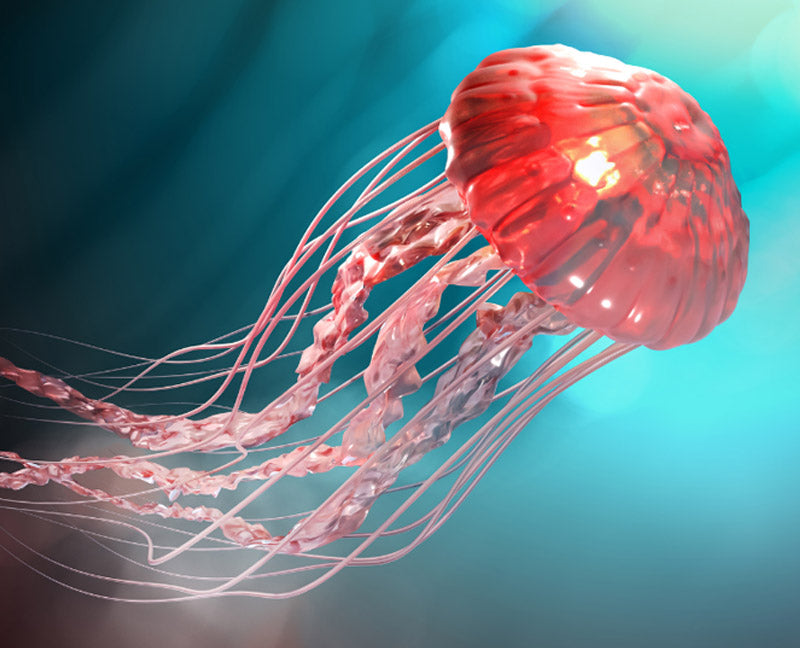
The allure of the ocean is undeniable, with its vast expanse of blue and an ecosystem teeming with intriguing creatures. However, beneath the surface, the tranquil waters can hide some of nature's most formidable and enigmatic inhabitants—dangerous jellyfish. In this comprehensive guide, we'll delve into the world of the top 5 perilous jellyfish species, uncovering their habitats, unique characteristics, dangers posed, and the vital role of the trusty stingersuit in ensuring your safety during stinger season.
The Top 5 Dangerous Jellyfish
Box Jellyfish (Chironex fleckeri)

Habitat: These ruthless marine predators inhabit the coastal waters of northern Australia, particularly in the tropical haven of Queensland.
Season: Beware during the balmy months from October to May, as they make their presence known.
Characteristics: Sporting a pale blue or transparent bell, box jellyfish conceals nearly invisible tentacles lined with venomous harpoon-like structures.
Danger posed: Their tentacles inject potent venom with nematocysts, causing immediate and severe pain. Severe stings can lead to nausea, muscle cramps, and even cardiac arrest, potentially being lethal without prompt treatment.
Protection: When treading Queensland's waters during stinger season, a trusty stinger suit is your fortress of defense against box jellyfish stings.
Shop the Brave Beachwear range of stinger suits for box jellyfish here.
Portuguese Man o' War (Physalia physalis) [Or Bluebottles in Aus]

Habitat: These captivating but perilous creatures float in warm oceans worldwide, often lurking near the water's surface.
Season: Portuguese man o' wars don't adhere to a specific season, remaining a year-round concern in tropical and subtropical waters.
Characteristics: Resembling a marine balloon, their long, trailing tentacles can reach a staggering 30 feet in length.
Danger posed: Stings cause intense localized pain, redness, and swelling. In some cases, systemic reactions like fever and muscle pain can occur, especially with multiple stings.
Protection: As these creatures roam unpredictably, your 'stinger suit' should be your constant companion in these waters.
Irukandji Jellyfish (Carukia barnesi)

Habitat: The Great Barrier Reef, specifically the coastal waters of northern Australia, is the Irukandji's preferred playground.
Season: They come to life during stinger season, typically spanning from November to May.
Characteristics: Irukandji jellyfish are pint-sized, with translucent bodies measuring less than an inch in diameter. There are hundreds of sub species of Irukandji, some that have not even been researched yet.
Danger posed: Stings lead to severe pain, muscle cramps, nausea, and a sense of doom. Small size and delayed symptoms make them deceptive.
Protection: In waters prone to Irukandji encounters, a stinger suit is not an option—it's a necessity.
Shop the Brave Beachwear range of stinger suits for Irukandji jellyfish here.
Morbakka (Morbakka Fenneri) [Or Fire Jelly in Aus]

Habitat: These creatures are found mainly on the coastal open waters of eastern Australia.
Season: All year round, but peak season aligns with the wet season, from October to April.
Characteristics: Large transparent box-shaped bell with one tentacle in each corner. The bell can be 6-18cm wide with 4 thick, ribbon-shaped tentacles that may be up to 1m long. An open water species.
Danger posed: Stings cause localized pain, welts, and potential systemic symptoms like nausea. North of Agnes Waters these jellyfish can cause Irukandji symptoms.
Protection: When venturing into jellyfish territory, your stinger suit becomes your ultimate shield against their potent stings.
Lion's Mane Jellyfish (Cyanea capillata) [Or a Snottie in Aus]

Habitat: The lion's mane jellyfish is found Australia wide and prefers the colder waters of the northern Atlantic and Arctic Oceans.
Season: These captivating but potentially dangerous jellyfish emerge primarily during late spring and summer.
Characteristics: Their vibrant red or yellow color and long, trailing tentacles are their signature traits. The largest lion's mane jellyfish can sport tentacles exceeding 30m in length.
Danger posed: Striking long tentacles can cause localized pain, swelling, and rash. Severe cases may result in nausea and muscle pain, but these are uncommon.
Protection: Even in colder waters, donning a stinger suit is recommended for safeguarding against lion's mane jellyfish stings.
Protecting Yourself During Stinger Season
Stinger season may bring forth potentially perilous jellyfish, but with the right knowledge and protective gear, you can confidently explore the ocean's depths. The stinger suit is your trusted ally, providing an effective barrier against jellyfish tentacles. When venturing into stinger-infested waters, remember to:
- Stay Informed: Keep aware of local advisories and stinger season updates.
- Suit up: Wear your bravesuit during the stinger season.
- Exercise Caution: Avoid sudden movements and steer clear of floating objects.
- Carry a First Aid Kit: Vinegar for box jellyfish stings and tweezers for tentacle removal are essential.
- Buddy Up: Swimming or engaging in watersports with a companion enhances safety.
The Brave Beachwear range of stinger swimsuits not only meets all the crucial requirements for protection but also allows you and your family to enjoy the water in style. Shop our great range here.
As you embark on your aquatic adventures, remember that stinger season is no deterrent for enthusiasts of the sea. Armed with knowledge, respect for nature, and your trusty stinger suit, you can navigate the ocean's wonders while staying protected from the mesmerizing yet potentially perilous world of jellyfish. So, gear up, dive in, and explore the beauty of the ocean with the confidence that you are prepared for any encounter with these remarkable marine creatures.
Shop the safe and stylish Brave Beachwear range of stinger suits here.
There’s something for the whole family.
